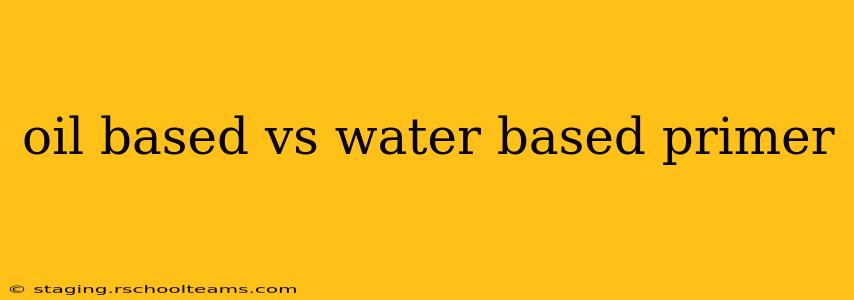Choosing the right primer is crucial for a successful paint job. Whether you're a seasoned professional or a weekend warrior tackling a DIY project, understanding the differences between oil-based and water-based primers is essential for achieving a smooth, durable, and long-lasting finish. This guide will delve into the key distinctions, helping you make the best choice for your specific needs.
What are the Key Differences Between Oil-Based and Water-Based Primers?
The fundamental difference lies in their base solvents: oil-based primers use mineral spirits or solvents, while water-based primers, as the name suggests, use water. This seemingly small difference leads to significant variations in their properties, application, and suitability for different projects.
Drying Time
Oil-based primers take significantly longer to dry, often requiring several hours or even overnight. This extended drying time can be both an advantage and a disadvantage, depending on the project. The slower drying allows for more thorough blending and correction of imperfections.
Water-based primers, on the other hand, dry much faster, usually within a few hours, making them ideal for projects where time is of the essence. However, this rapid drying can sometimes lead to a less smooth finish if not applied carefully.
Cleanup
Oil-based primers require mineral spirits or solvent-based cleaners for cleanup, which can be messy, require proper ventilation, and are environmentally less friendly. Disposal of these solvents also requires careful attention to local regulations.
Water-based primers are easily cleaned up with soap and water, making them a much more convenient and environmentally conscious choice. This simplicity reduces cleanup time and minimizes the environmental impact.
Durability and Adhesion
Both oil and water based primers offer excellent adhesion and durability when applied correctly. However, oil-based primers are often considered more durable and better at sealing stains, especially on porous surfaces like wood. They form a hard, protective layer that effectively prevents bleed-through from underlying stains or knots.
Water-based primers have advanced significantly in recent years, offering excellent adhesion and stain-blocking capabilities, especially the higher quality options. They are often preferred for their low VOC (volatile organic compound) content, making them a healthier choice for both the user and the environment.
VOC Content
Oil-based primers typically have a higher VOC content compared to water-based counterparts. VOCs contribute to air pollution and can be harmful to human health. Therefore, water-based primers are often preferred in well-ventilated areas, like homes or workplaces where people may be sensitive to strong smells.
Surface Preparation
Proper surface preparation is crucial regardless of the primer type chosen. Both oil-based and water-based primers require a clean, dry, and sound surface. Loose paint, dust, dirt, and grease should be removed before application. For surfaces that are heavily stained or have substantial imperfections, sanding may be necessary to ensure optimal adhesion.
Which Primer is Right for Me? Oil-Based or Water-Based?
The choice depends on your specific project and priorities.
-
Choose oil-based primer if:
- You need superior stain-blocking capabilities, particularly on porous surfaces like wood.
- You're working with a highly textured surface that requires extra sealing.
- You prefer a longer open time for blending and corrections.
-
Choose water-based primer if:
- You prioritize a quick drying time.
- You need an environmentally friendly option with low VOCs.
- Easy cleanup is a high priority.
- You are working in an area with limited ventilation.
What is the best primer for interior walls?
For interior walls, a high-quality water-based primer is generally recommended. Its low VOC content, easy cleanup, and fast drying time make it a convenient and healthy option. Look for primers specifically designed for interior walls that offer good adhesion and stain-blocking properties.
What is the best primer for exterior wood?
For exterior wood, an oil-based primer offers superior protection against moisture and the elements. Its durability and stain-blocking capabilities will help preserve the wood and prolong the life of the paint job. However, ensure proper ventilation when working with oil-based products.
Can I use water-based primer over oil-based paint?
Generally, it's not recommended to apply water-based primer directly over oil-based paint. The incompatibility between the two can lead to adhesion problems and peeling. It's best to thoroughly remove the existing oil-based paint before applying a water-based primer.
Can I use oil-based primer over water-based paint?
Applying oil-based primer over water-based paint is generally acceptable, but it's crucial to ensure the water-based paint is completely cured and dry before application. Proper surface preparation is key to ensure good adhesion.
This guide provides a comprehensive overview of oil-based versus water-based primers. Remember to always follow the manufacturer's instructions for best results. Choosing the right primer ensures a superior paint job that looks great and lasts.
